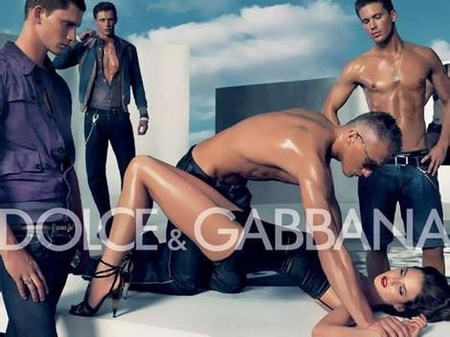Advertisements, regardless of how creative such works of art could be, sometimes does not necessarily goes well with the audience they are made for. The use of imagery and controversial issues might attract the attention of the audience, but it could offend the public the advertisements are made for.
Dolce & Gabbana, an Italian fashion house received much criticism once again for their scandalous advertisements in 2007. Reuters reported that Dolce & Gabbana decided to pull advertisements from Spain after Spanish authorities called for a ban of the advertisements which "incited violence against women."
 The advertisement for Dolce & Gabbana's Spring Summer 2007 collection drew flak from media watchdogs and Spanish authorities as the advertisement featured "a bare-chested man holding down a woman by her wrists while other men look casually on." (Source: Frillr.com 2007).
The advertisement for Dolce & Gabbana's Spring Summer 2007 collection drew flak from media watchdogs and Spanish authorities as the advertisement featured "a bare-chested man holding down a woman by her wrists while other men look casually on." (Source: Frillr.com 2007). Walsh (2006) noted that a picture could evoke possible scenarios and readers could respond to it imaginatively or effectively. A simple glance could prompt readers that the advertisement is about violence against women, instead of one by a fashion house. To make things worst, the men standing in the background could suggest to the readers that it is okay for men to act in a violent manner towards women.
The advertisement would not have created such havoc if the action in the advertisement were so vividly obvious. The words "DOLCE & GABBANA" printed right across the women who is being pinned down by a man is the strongest visual clues of the advertisement where the greater the weight of the element in a composition, the greater the salience (Kress & van Leeuwen 1996). Should the action happened in the background of the advertisement and not the foreground, the advertisement might not have been so offensive.
In a nutshell, the visually creative advertisement failed to capture the hearts of the audience. Schriver (1997) stressed that "document designers who misunderstands their audience and their frame of reference can create documents that evoke confusion, and in some cases even anger." Having said that, document designers should be more aware of who their audience are and understand that not everybody is comfortable with various controversial issues.
Reference:
Dolce and Gabbana pulls 'humiliating' ads after Spanish objections 2007 , ABC News, viewed 7 November 2008, <http://www.abc.net.au/news/stories/2007/03/14/1871208.htm>.
Kress, G, van Leeuwen, T, 1996, Reading Images: The Grammar of Visual Design, Routledge, London.
Schriver, KA 1997, Dynamics in document design: creating texts for readers, Wiley Computer Publication, New York.
Walsh, M 2006, ‘The ‘textual shift’: Examining the reading process with print, visual and multimodal text’, Australian Journal of Language and Literacy, vol. 29, no. 1, pp. 24-37.

2 comments:
If we decipher the message of the campaign from the ad itself, it would probably come across as 'D&G promotes rape, violence and abusive behaviour towards women'. Or it could just mean 'LOOK AT ME I HAVE SO MANY NICE CLOTHES FOR MEN TOO AND MY CLOTHES FOR WOMEN IS JUST SO HOT THAT MEN JUST HAVE TO HAVE ME RIGHT THERE AND THEN. AND I LOOK FAB DOING IT TOO.'
I would agree with the former, but only to the extent that it is a rational, left-brain interpretation of the ad, as opposed to a visceral, right-brain interpretation.
Ads, especially high-fashion ads, rely on id-driven imagery which is usually full of eroticism, just as the appeal of avant-garde and abstract art and otherwise really expensive art cannot be explained by the rational mind. That's why gold-plated tanks of sharks in formaldehyde and portraits of dancing obese women get sold for obscenely high prices; it gives people that experience, but can it be explained and is it the same experience for all who experienced it?
So my two cents is: this ad was probably designed to cater to some kink in our ids. It's far more meaningful to the inner animal in us then just models looking pouty and sexy in ambiguously glamorous situations, but it happens to be really offensive to our moral, conscious mind. Kinda like Eva Mendes writhing naked on a bed for CK, but just more ambiguous?
Oh yeah, my verification word for this comment is behera. Awesome coincidence much?
what i learnt in my previous media criticism class was, when an ad, this Dolce & Gabbana ad for instance, portrays one woman and a few men, it actually plays around a woman's fantasy, as she likes being the center of attention, and likewise, how one man loves the attention of a few women.
to the naked eye, one glance, it might be offensive because it's almost seemed like D& G condones violence, women love the aggressiveness of the men, and the whole enchilada.
it's definitely controversial, but it appears to me women ( excluding me) seems to fight alot for their equality, and in this ad, D&G is just giving it to them. *shrugs*
just my two cents. ;)
Post a Comment